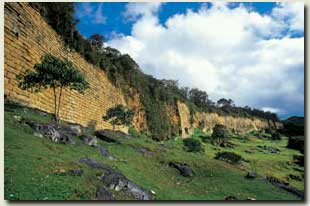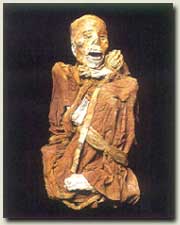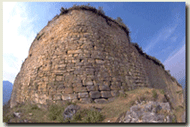This journey through the landscape and history of Peru’s little-known northern region is a revelation and a magical experience for many of our visitors. The program is intended for travelers with a special interest in archaeology, and a taste for adventure. This region is still new to tourism, but we have taken every care to provide as comfortable a stay as possible, with air-conditioned vehicles, expert guides and the best possible accommodation.
We mingle trips on foot and/or horseback with light motorized excursions and longer road journeys, visiting astounding locations and rarely seeing more than a handful of other travelers at each place.
Note: We require minimum two passengers traveling together If single traveler ask for the supplement.
| Duration | 10 Days and 9 Nights |
| Departures | Available on Monday, Wednesday and Saturday |
| Activities | Chachapoyas, Kuelap citadel, Leymebamba – starting from Lima Peru |
| Airfares | Not included, available upon request |
PROGRAM
DAY 1 LIMA PICK UP
DAY 2 LIMA TO CHICLAYO: THE “CRACKED PYRAMID”, TÚCUME, AND THE ROYAL TOMBS OF SIPÁN.
A highly informative site museum tells the story of this extraordinary civilization, who created some of the finest pottery, jewelry and gold working of the Americas — while also staging macabre costumed rituals of combat, sacrifice and propitiation as they sought to mediate a never ending struggle between the forces of Order and Chaos.
We return to Chiclayo for a delicious lunch of Peru’s northern-style cuisine, and then continue on to Lambayeque, where we visit the Royal Tombs of Sipán Museum. This modern building, representing the style of a Moche pyramid, was built to house the stunning and priceless objects unearthed at Sipán. (A single looted object from the tombs was intercepted at an auction in the U.S. — carrying a reserve price of $1.6 million!)
Here we see the incredible array of precious symbols and images, stones and shell necklaces, ear-plugs and headdresses that were worn and displayed at Moche ceremonies, and also learn what is known of their meaning. This astonishing visit ends at an “animated waxworks” exhibit of the lords and retinue of the Moche court, allowing us to glimpse and imagine the world of an unfamiliar but dazzling civilization that thrived here at a time when Europe was sliding into the Dark Ages after the fall of the Roman Empire.
After these sensational experiences we drive to an oasis of calm at Tucumé, today’s final destination. Here we see the chronological sequence that followed the fall of the Moche, at a site where their descendants, the Sicán culture, continued to amass millions of adobe bricks for the building of mighty pyramids (including the longest of its kind in the world, at more than 700m/2,300ft) but were now influenced by highland tribes, and began to abandon their old ways. The history of this scenic site — extensively investigated by the famed Norwegian explorer Thor Heyerdahl — leads us all the way to the Incas, who conquered the region not long before they, in turn, were conquered by the Spanish. We can climb to a viewing platform with superb views of the surrounding pyramids and the dry woodland habitat of the Leche valley. We can also visit the small, intimate and low-tech site museum, to enjoy the excellent collection of excavated objects, dioramas of daily life, and models of the pyramids.
We return to Chiclayo for an overnight stay. (Box lunch, D)
DAY 3 CHICLAYO TO CHACHAPOYAS: ACROSS THE ANDES TO THE AMAZON
We reach the bridge over the Marañon, one of the great tributaries of the Upper Amazon, which was formerly believed to be the source of that mighty river. Here we enter the Peruvian department of Amazonas, former home of a mysterious and powerful civilization, the Chachapoyas, whose remnants we will explore during this journey.
We follow the Utcubamba River, the main artery of the Chachapoyan heartland, first ascending a dramatic canyon then winding up the mountainous valley which leads us to El Chillo, our hotel at the foot of the high road to the mountaintop site of Kuelap, tomorrow’s destination. (B, Box Lunch, D)
DAY 4 CHACHAPOYAS: KUELAP, THE GREAT WALLED CITY OF NORTHERN PERU
Kuelap’s existence was first reported in 1843. For years it was believed to have been a Chachapoyan fortress, and when we first catch sight of it from the fossil-encrusted limestone footpath that leads there it is hard to believe it was not. The massive walls soar to a height of 19m/62ft and its few entranceways are narrow and tapering, ideal for defense. Yet the archaeological evidence now suggests that this was principally a religious and ceremonial site.
Chachapoyas was not a nation or an empire, but some sort of federation of small states centered on numerous settlements scattered across their mountainous territory. The earliest settlement dates obtained here suggest that its construction began around 500A.D. and, like the Moche coastal pyramids, it was built in stages as a series of platforms, one atop the other.
It is now a single enormous platform nearly 600m/2,000ft long, stretched along a soaring ridgetop. Seen from below, its vast, blank walls give no hint of the complexity and extent of the buildings above. When we reach its summit we find a maze of structures in a variety of styles and sizes, some of them faced with rhomboid friezes, some ruined and some well preserved. Here we can try to imagine the lives of the Chachapoyan elite and their servants who lived here, enjoying a breathtaking view of forested Andean mountains and valleys.
So distant and neglected was this region until recently that little archaeological research has been done at this important site, and our knowledge of it remains vague. An adjacent site named La Mallca, larger though less dramatic than Kuelap, has not been studied at all. Even today, Kuelap’s remoteness ensures that only a handful of other visitors are there to share it with us.
We return to El Chillo for dinner. (B, Box Lunch, D)
DAY 5 CHACHAPOYAS TO LEIMEBAMBA: JOURNEY TO THE CLIFF TOMBS OF REVASH, AND ON TO A TRADITIONAL ANDEAN TOWN
Throughout this journey we gaze up at huge cliffs that loom ever closer. These limestone formations, laid down in even layers over geological eons, tend to break away in neat collapses, often leaving extensive overhangs and protected ledges beneath them. In such places the ancient Chachapoya built the tombs where they buried their noble dead.
A gigantic fold in the cliffs, testifying to millennia of unimaginable tectonic forces, lies ahead of us, and at the top of the fold one such cave houses a group of tombs, ruined structures still bearing their original coat of red and white pigment. But they are far off, and this is not yet Revash. Another hour brings us to a viewpoint much closer to the cliffs, and here we see two adjacent sets of caves, featuring cottage-sized structures covered in still-bright mineral-oxide paintwork. Some of them look like cottages, with gabled roofs, others like flat-topped apartments. They are adorned with red-on-white figures and geometrical symbols — a feline, llamas, circles, ovals — and bas-relief crosses and T-shapes, which perhaps once told the rank and lineage of the tombs’ occupants. They are silent, empty, their contents long ago looted, their facades still straining to tell a story whose meaning was lost long ago.
Retracing our steps we continue our road journey to Leimebamba, which we reach mid-afternoon. This settlement was established by the Incas during their conquest of the region, and continued as a colonial town under the Spanish. It retains much of this antique charm in its balconied houses with narrow streets where more horses than cars are parked. We go a little further up the highway and pull in to the spacious garden environment of the Leimebamba Museum, where we settle in to guest rooms specially provided for visitors. Then we visit this delightful collection of extraordinary artifacts recovered from another group of cliff tombs discovered as recently as 1997 at the remote Laguna de los Condores, high in the mountains east of the town.
The exhibits, cheerfully displayed in well-lit rooms, offer a sample from the mass of artifacts recovered from this amazing discovery. In 1997 a group of undiscovered cliff tombs — similar in style to those of Revash — was spotted above the remote Laguna de los Condores by local farmhands. Although they looted and damaged the site, a mass of priceless objects and a trove of vital information was rescued. We see gourds carved with animal and geometrical symbols, an array of colorful textiles, ceramics, carved wooden beakers and portrait heads, and a selection of the dozens of quipus (Inca knotted-string recording devices) recovered from the site. A big picture window offers a view of the temperature- and humidity-controlled temporary “mausoleum” where more than two hundred salvaged mummies are kept.
Archaeologists are still uncertain as to how most of this material came to be so startlingly well-preserved, in tombs that during the rainy season were actually behind a waterfall! But perhaps the most striking thing about the tombs is that they contain burials from all three periods of local history: the Chachapoya cultural heyday, the post-Inca invasion period, and the post-Spanish conquest. Archaeologists are continuing to study the material, seeking to learn more about the Chachapoya and their relationship with their Inca masters. The quipu finds have been especially valuable to scholars seeking to decode the Inca record keeping system.
After our museum tour we can visit the Kenticafé across the street, for a cup of the best coffee in Chachapoyas, where we may see dozens of the region’s exotic hummingbirds flitting among the strategically placed feeders, perhaps including the dazzling and highly endangered Marvelous Spatuletail. (B, Box Lunch, D)
DAY 6 LEIMEBAMBA TO CAJAMARCA: ACROSS THE MARAÑON CANYON
We cross the mighty river into the Department of Cajamarca, and climb through an arid canyon environment of tall cactus and gnarled trees. Eventually we reach farmland again, rolling country of wheat, barley and oat fields, and we begin to see adobe farmhouses. And we spot farmers and their children wearing the characteristic large, broad-brimmed Cajamarca straw hat. We pause in the city of Celendín for lunch, and continue on to our destination, the regional capital of Cajamarca. We arrive late afternoon at the Cajamarca suburb of Baños del Inca, where the spacious Laguna Seca Hotel offers us a welcome rest and a room with its own huge hot tub and unlimited piping-hot thermal spring water.(B, L, D)
DAY 7 IN CAJAMARCA: COLONIAL SPAIN AND THE LAST DAYS OF THE INCA EMPIRE.
Today we drive into the city center, and up to the hilltop now known as Colina Santa Apolonia. This was a sacred mountain to the Cajamarca people who held sway in this valley for nearly two thousand years, until the Incas conquered them, and ancient rock carvings can still be seen on its summit. Today we look out over the modern city of some 250,000 inhabitants, spread out over a valley at 2,700m/8,850ft surrounded by low mountains. After viewing the lay of the land we descend the steps into the old city center, which lies directly below us.
Spanish colonial houses line the streets here, and the churches, such as San Francisco and Belén, wear facades of intricate, fantastical baroque-mestizo stonework, although all trace of the Inca halls from which Francisco Pizarro and his conquistadors launched history’s most fateful and treacherous ambush have disappeared. Nevertheless, we visit one Inca stone building that still stands, its smoothly rounded stone walls and perfectly fitted stones testifying to its noble Inca origins. Local folklore holds that this was the room which the Inca Atahualpa offered to fill once with gold and twice with silver, in exchange for his freedom. This forlorn monument is a suitable spot to hear the story of Atahualpa’s fabulous ransom and its tragic denouement.
We visit the Museum in the old colonial hospital of the Church of Belen, to get in touch with and see some fine artifacts from an older culture — known to us as the Cajamarca — who occupied this valley for some 2,000 years before finally succumbing to the Inca expansion.
After lunch at a fine local restaurant we pay a visit to the nearby rock formation at Otuzco, where over thousands of years the pre-Inca Cajamarca peoples left hundreds of elaborate niches, or “windows”, hewn into bedrock, in which they buried their dead. We return in time to make the most of the facilities at the hotel before dinner. (B, L, D)
DAY 8 CAJAMARCA TO TRUJILLO: FROM MOUNTAIN CITY TO COASTAL DESERT
The route across the rolling mountain scenery of the Cajamarca valley and dramatic descent through rugged ravines to the coast offers another sample of Peru’s startling varieties of terrain and geography. We will stop for an open air picnic lunch at a scenic spot overlooking the great lake behind the Gallito Ciego dam. If time allows we can combine this with a visit to the nearby petroglyphs of Yonán. By early afternoon we meet the Pan-American highway 120 Km. north of Trujillo, and finish our journey on a major paved highway.
In Trujllo we have time to get our bearings in the city center, with its spacious Main Square, and marvelous colonial-period adobe buildings in the coastal colonial style, featuring huge barred windows and massive wooden doorways. We take time to see one of these — the Casa de la Emancipación, now a bank, but open to the public. This is the former colonial mansion where rebellious local citizens proclaimed independence from Spain, ahead of the rest of Peru, in 1820. The colonial atmosphere and decor have been faithfully preserved, and there is a display model of old Trujillo, from a time when a fortified wall protected the city from pirate raids (B, Box lunch, D)
DAY 9 THE GREAT ADOBE PLATFORMS OF HUACA DE LA LUNA AND HUACA DEL SOL, THE PICTURESQUE BEACH RESORT OF HUANCHACO, AND THE PRE-INCA CITY OF CHAN CHAN.
We make our way through Trujillo to the seashore, stopping en route to see the Huaca del Dragón, a pyramid built by the Chimú culture, a dynasty that assumed power after the Moche in this part of Peru until they were conquered by the Incas.
At the nearby beach resort of Huanchaco we have a chance to try the superb seafood of Trujillo at a restaurant overlooking the Pacific Ocean. Here fishermen still paddle out to sea, kneeling on caballitos de totora — one-man reed rafts which have been used for millennia to collect the abundant bounty of the Pacific Ocean.
After lunch we visit the great Chimú center of Chan Chan, the largest adobe city ever built. It was in fact an elite settlement, a series of nine enormous palaces belonging to successive rulers of the Chimú realm. At its height the population here may have reached 50,000 people. Many of them were artists and craftspeople, who made the sumptuous gold work, textiles and pottery for which the Chimú were famous. At the Tschudi palace enclosure we enter a labyrinthine series of courtyards lined with clay friezes of fish and ocean birds, and surrounded in places with open meshwork-style adobe walls, believed to represent fishing nets. We visit inner patios, residences, administrative buildings, temples, platforms and storehouses, and a huge reservoir where “sunken gardens” may have produced specialized crops for the Chimu nobility.
We return to Trujillo in time for our evening flight to Lima (Airfare not Included). Upon arrival transfer to the hotel. Overnight(B,L)
DAY 10 TRANSFER OUT

Kuelap Fortress
Pre-Inca Mummie
Kuelap
WOULD YOU LIKE TO BOOK THIS TOUR ? ASK FOR AVAILABILITY
INCLUDES: All hotel and lodge accommodations based on double or single occupancy. All scheduled transportation. All transfers. All scheduled excursions with English-speaking guide services. All entrance fees. Meals as specified in the itinerary. B=Breakfast; L=Lunch; D=Dinner.
IMPORTANT: For a better service, the company informs you that it has autonomy to change the Hotels mentioned in the itinerary with another one of similar category if therefore sees it by advisable taking into account justifiable availability of spaces or other reasons, if this it is the case you will be notified ahead of time.
NOT INCLUDED IN THE FEE
International and domestic airfares, airport departure taxes or visa fees, excess baggage charges, additional nights during the trip due to flight cancellations, alcoholic and non-alcoholic beverages or bottled water, snacks, insurance of any kind, laundry, phone calls, radio calls or messages, reconfirmation of international flights and items of personal nature.



